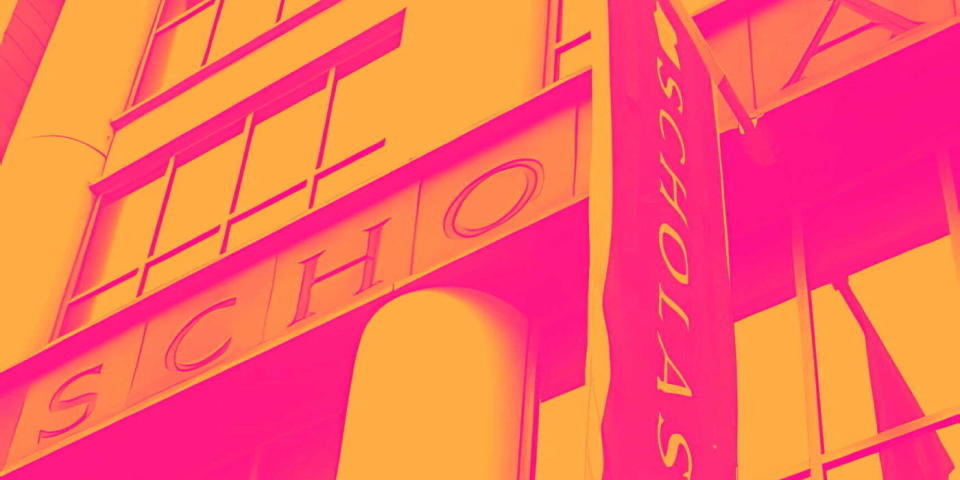Scholastic (NASDAQ:SCHL) Misses Q2 Revenue Estimates, Stock Drops 10.5%

Educational publishing and media company Scholastic (NASDAQ:SCHL) missed analysts' expectations in Q2 CY2024, with revenue down 10.1% year on year to $474.9 million. It made a GAAP profit of $1.23 per share, down from its profit of $2.27 per share in the same quarter last year.
Is now the time to buy Scholastic? Find out in our full research report.
Scholastic (SCHL) Q2 CY2024 Highlights:
Revenue: $474.9 million vs analyst estimates of $552.5 million (14% miss)
EPS: $1.23 vs analyst estimates of $2.66 (53.8% miss)
Gross Margin (GAAP): 59.5%, up from 58.3% in the same quarter last year
Free Cash Flow of $49.7 million is up from -$7.1 million in the previous quarter
Market Capitalization: $1.07 billion
Peter Warwick, President and Chief Executive Officer, said, "Scholastic made significant progress last quarter advancing our 360-degree content creation strategy, as we expand our opportunities as a global children's media company. With the addition of the award-winning 9 Story Media Group to our portfolio, announced in March and closed last month, our new Scholastic Entertainment segment has gained industry-leading production, distribution and licensing capabilities, an extensive children's content library, and a highly talented team. After only a month, the combined business is already executing on an expanded development and production slate, updating franchise and licensing plans for top Scholastic brands, and planning to leverage 9 Story's strong YouTube presence and expertise across Scholastic's content."
Creator of the legendary Scholastic Book Fair, Scholastic (NASDAQ:SCHL) is an international company specializing in children's publishing, education, and media services.
Media
The advent of the internet changed how shows, films, music, and overall information flow. As a result, many media companies now face secular headwinds as attention shifts online. Some have made concerted efforts to adapt by introducing digital subscriptions, podcasts, and streaming platforms. Time will tell if their strategies succeed and which companies will emerge as the long-term winners.
Sales Growth
A company's long-term performance is an indicator of its overall business quality. While any business can experience short-term success, top-performing ones enjoy sustained growth for multiple years. Scholastic struggled to generate demand over the last five years as its sales dropped by 1.1% annually, a rough starting point for our analysis.

Long-term growth is the most important, but within consumer discretionary, product cycles are short and revenue can be hit-driven due to rapidly changing trends and consumer preferences. Scholastic's annualized revenue declines of 1.6% over the last two years align with its five-year trend, suggesting its demand consistently shrunk.
This quarter, Scholastic missed Wall Street's estimates and reported a rather uninspiring 10.1% year-on-year revenue decline, generating $474.9 million of revenue. Looking ahead, Wall Street expects sales to grow 8.9% over the next 12 months, an acceleration from this quarter.
When a company has more cash than it knows what to do with, buying back its own shares can make a lot of sense–as long as the price is right. Luckily, we’ve found one, a low-priced stock that is gushing free cash flow AND buying back shares. Click here to claim your Special Free Report on a fallen angel growth story that is already recovering from a setback.
Cash Is King
Read MoreIf you've followed StockStory for a while, you know we emphasize free cash flow. Why, you ask? We believe that in the end, cash is king, and you can't use accounting profits to pay the bills.
Scholastic has shown weak cash profitability over the last two years, putting it in a pinch as it gave the company limited opportunities to reinvest, pay down debt, or return capital to shareholders. Its free cash flow margin averaged 5%, subpar for a consumer discretionary business.

Scholastic's free cash flow clocked in at $49.7 million in Q2, equivalent to a 10.5% margin. The company's margin regressed as it was 7.5 percentage points lower than in the same quarter last year, but we wouldn't put too much weight on it because working capital and capital expenditure needs can be seasonal, causing quarter-to-quarter swings. Long-term trends carry greater meaning.
Key Takeaways from Scholastic's Q2 Results
We struggled to find many strong positives in these results. Its revenue and EPS fell short of Wall Street's estimates. Overall, this was a bad quarter for Scholastic. The stock traded down 10.5% to $32.71 immediately following the results.
Scholastic may have had a tough quarter, but does that actually create an opportunity to invest right now? When making that decision, it's important to consider its valuation, business qualities, as well as what has happened in the latest quarter. We cover that in our actionable full research report which you can read here, it's free.